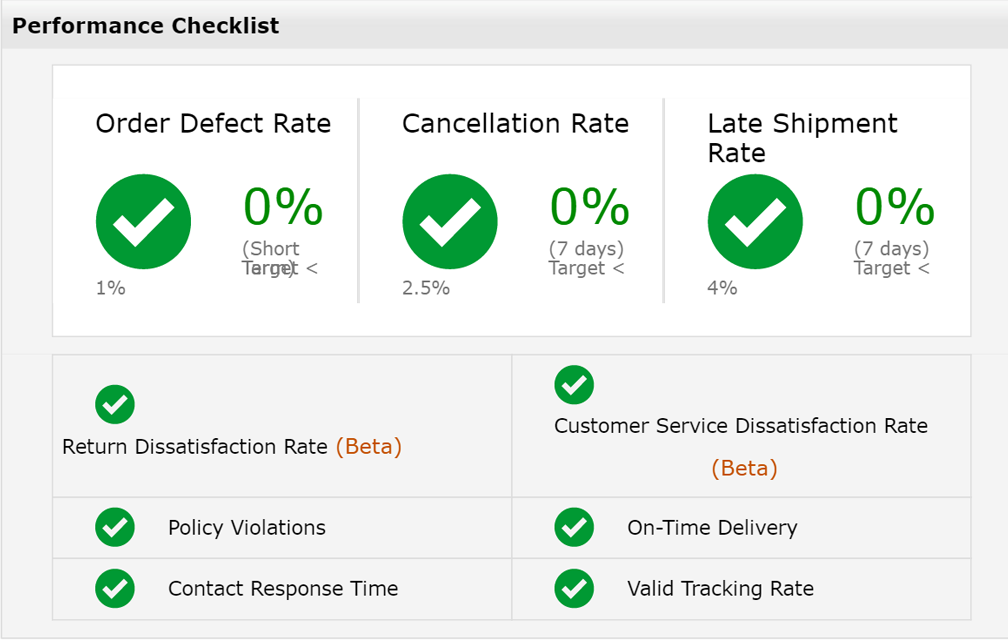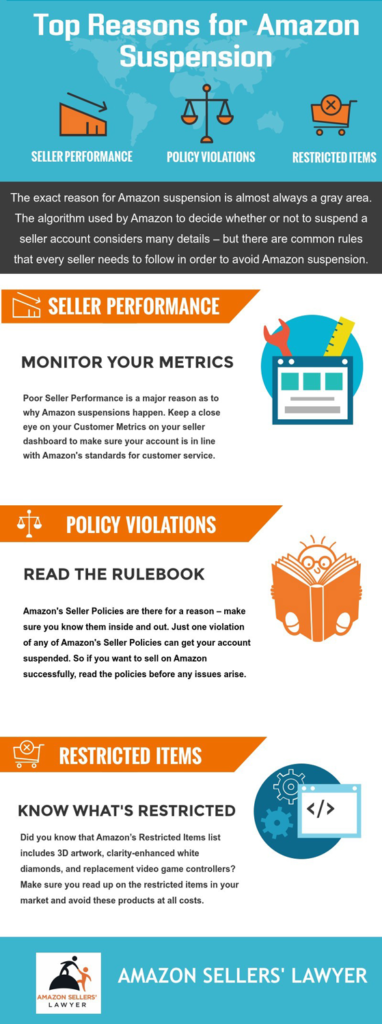How to Handle an Amazon Suspension: So, your account or listing has been suspended on Amazon.. What to do? The next steps to get your seller account reinstated largely depend on why your account has been suspended. If the email you receive from Amazon does not clearly outline why you’ve been suspended, you can always contact us for a consultation on the best way to deal with your situation 1-877-9-SELLER.
We’ll write your Plan of Action for you.
Writing an effective plan of action is complex, with numerous factors that need to be included depending on the reasons for your Amazon suspension. Regardless, disputing your Amazon suspension and getting reinstated is a hurdle you can overcome with research, dedication and persistence to get your Amazon account reinstated. Let us help you with this crucial process.
Amazon suspensions are more common than many sellers are aware of. If you want to run a successful ecommerce business on Amazon, it’s crucial to understand why accounts / listings get suspended, how to avoid a suspension, and what to do if you become suspended.
Why Amazon Sellers Get Banned – Top Reasons for Amazon Suspensions
The exact reason for an Amazon suspension can sometimes be a gray area. The intricate algorithm used by Amazon takes into account many unique factors based on your seller performance – but overall, there are common rules that every seller needs to follow in order to avoid Amazon suspension.
Amazon suspensions generally come down to the level of customer service.
If you monitor your metrics every day, answer every customer message in the specified time frame, and handle any potential issues immediately, your seller performance will reflect your effort. But if you ignore the metrics and provide customer service that does not live up to Amazon’s standards, you are setting yourself up for a major Amazon failure.
 #1: Policy Violations
#1: Policy Violations
The Amazon Seller Policies are there for a reason – when you’re selling on Amazon, make sure you know them inside and out. Even one violation of any single policy set forth by Amazon can get your account flagged for suspension. It’s understandable – most of us don’t read the complete terms of agreement when we sign up for something online. But if you want to sell on Amazon, reading every rule and regulation for sellers is an absolute must to avoid suspension.
How to Handle Amazon Suspension Due to a Policy Violation
Dig into the Amazon seller policies right away – learn them inside and out until you fully understand each regulation from every angle. Once you know the specific rule you broke, you can submit an appeal to Amazon that outlines how you will ensure the violation will not happen again.
#2: Poor Seller Performance
This is the most frustrating issue for so many Amazon sellers – what is the true definition of poor seller performance? The metrics are a great standard to work from, but there are other influential factors regarding seller performance that can get your account suspended without notice. To avoid Amazon suspension, monitoring your metrics on a daily basis is a great place to start.
How to Handle an Amazon Suspension Due to Poor Seller Performance
If you’ve been suspended for poor seller performance, check out your customer metrics right away. Where are you falling behind? Re-evaluate your business policies and why you haven’t maintained Amazon’s standard of customer service. Your plan of action must reflect how you will improve your seller performance in order to provide only the best customer service as an Amazon seller.
#3: Selling Restricted Items
You probably know that you can’t sell drug paraphernalia, shotgun shells, or beauty products made with chloroform on Amazon. Some of the restricted items are obvious – others, not so much. Did you know that Amazon’s Restricted Items list also includes 3D artwork, clarity-enhanced white diamonds, and replacement video game controllers? Make sure you read up on the restricted items in your market and avoid these products all together.
How to Handle an Amazon Suspension Due to Restricted Items
Amazon suspension regarding restricted items can be tricky, but getting reinstated is absolutely possible if you handle the situation correctly. When you receive notice of your suspension, remove the items in question immediately and indicate in your plan of action how you will ensure that none of these items appear in your listings again.
Our law firm is here for you 7 days a week.
We offer free consultations for Amazon sellers who are suspended. Call today 1-877-9-SELLER.
Understanding Amazon’s Customer Metrics
When it comes to an Amazon suspension, your customer metrics are a major factor as to whether or not your account is at risk. Amazon added three new metrics to assess your seller performance: Return Dissatisfaction Rate (added November 2015), Valid Tracking Rate (added July 2015), and Customer Service Dissatisfaction Rate (Added February 2016).
Now, your customer metrics overall include the following points:

You need to keep a close eye on each one of these customer metrics to keep your seller account in good standing and avoid any potential Amazon suspension.
- Order Defect Rate
- Cancellation Rate
- Late Shipment Rate
- Return Dissatisfaction Rate
- Customer Service Dissatisfaction Rate
- Policy Violations
- On-Time Delivery
- Contact Response Time
- Valid Tracking Rate
Here is an overview of each of Amazon’s customer metrics and what numbers you should aim for in order to avoid a suspended account or any other issues with Amazon.
Order Defect Rate: This important metric is the overall amount of orders that have been flagged with negative feedback, chargebacks, or A-Z claims. Your order defect rate, or ODR, is an important indication of your overall status as an Amazon seller. According to seller performance, a standard of less than 1% regarding order defects should be maintained. Remember, Amazon’s most important principle is customer obsession, and order errors are in direct opposition to that standard.
Cancellation Rate: This customer metric allows Amazon to measure the number of orders you have cancelled as compared to your total orders placed. When a seller account has a high number of cancellations, this can indicate some poor customer service practices such as lack of inventory, inaccurate item details, or damaged products. To calculate your cancellation rate, Amazon divides your total number of cancelled orders by the total number of orders in any particular time frame. Once again, Amazon does not factor in the reasons for cancellation – they simply require you as a seller to maintain their standard of customer service. To keep your account in good health and avoid Amazon suspension, complaints and violations, aim for a total of less than 2.5% orders cancelled.
Late Shipment Rate: Regardless of the reason for a late shipment, this customer metric is a strict standard of Amazon’s dedication to perfect customer service. To be precise, your late shipment rate is the exact number of shipments you have confirmed after the date of delivery expected by your buyer. As a seller, lack of attention to this metric can easily lead to Amazon suspension – late shipments tend to lead to increased complaints, poor feedback, and other issues with your account. To avoid any potential problems, maintain a level of less than 4% when it comes to late shipments.
Return Dissatisfaction Rate: This new customer metric, called your Return Dissatisfaction Rate, concerns how efficiently any return requests from your customers on Amazon are processed by you as a seller. This includes speed, incorrect refusals on returns requested, and poor customer service feedback. Aim for a target of less than 10% for your return dissatisfaction rate – but to be safe and avoid Amazon seller suspension issues, process every return immediately and refund all of your customers.
Customer Service Dissatisfaction Rate: The Customer Service Dissatisfaction Rate (Beta) measures overall customer satisfaction, along with how responsive you are to your customers. When a customer sends a message to an Amazon seller, the platform requires the customer to indicate whether their problem was solved by the seller or not. Your customer service dissatisfaction rate will be the percentage of total “no” answers you receive from your customers. To keep your seller account in good standing, aim for a dissatisfaction rate of less than 25%.
Policy Violations: Out of all the metrics, any number of policy violations on your account can lead to immediate Amazon suspension and put your selling privileges for the future at risk. Policy violations factored into this crucial customer metric include buyer complaints, charge backs, A-Z claims and various other violations of the intricate Amazon seller policies. If you see a notification of a policy violation on your seller dashboard, don’t wait – handle the situation immediately to avoid further issues.
On-Time Delivery: The on-time delivery metric calculates the number of shipments received by the specified date of delivery. As a seller, you can maintain this metric by confirming every shipment at the appropriate time and uploading valid tracking information for your buyers with every order you ship. According to Amazon, orders with the right tracking information provide approximately 60% fewer defects and a significant decrease in buyer complaints.
Contact Response Time: Although Amazon admits that late responses to customer inquiries usually does not directly lead to Amazon suspension, the Contact Response Time metric is important to monitor because of its impact on the other metrics. Slow response to buyers leads to an increase in negative feedback and buyer complaints, common seller performance problems that do lead to suspension. To keep up the standard of service required for response time, answer all customer messages in 24 hours or less.
Valid Tracking Rate: This customer metric requires all Amazon sellers to include valid tracking information for at least 95% of every single order (merchant-fulfilled only). Your valid tracking rate is calculated by dividing your total number of orders that were sent to customers with valid tracking numbers by the total number of non-FBA orders you ship out. What qualifies as “valid tracking” to Amazon? For starters, at least one carrier scan must be documented. Also, more than 97% of orders (merchant fulfilled) must be delivered by the date specified. Overall, shoot for a target of more than 95% when it comes to accurate tracking.
If you’ve been suspended on Amazon, contact us for a free consultation: 1-877-9-SELLER.
GET HELP NOW: The law firm of Rosenbaum Famularo, PC is required by law to assure you 100% confidentiality. We protect your privacy under the Attorney-Client Privilege.
Read about our law firm’s wins and reinstatements for Amz sellers.

 #1: Policy Violations
#1: Policy Violations